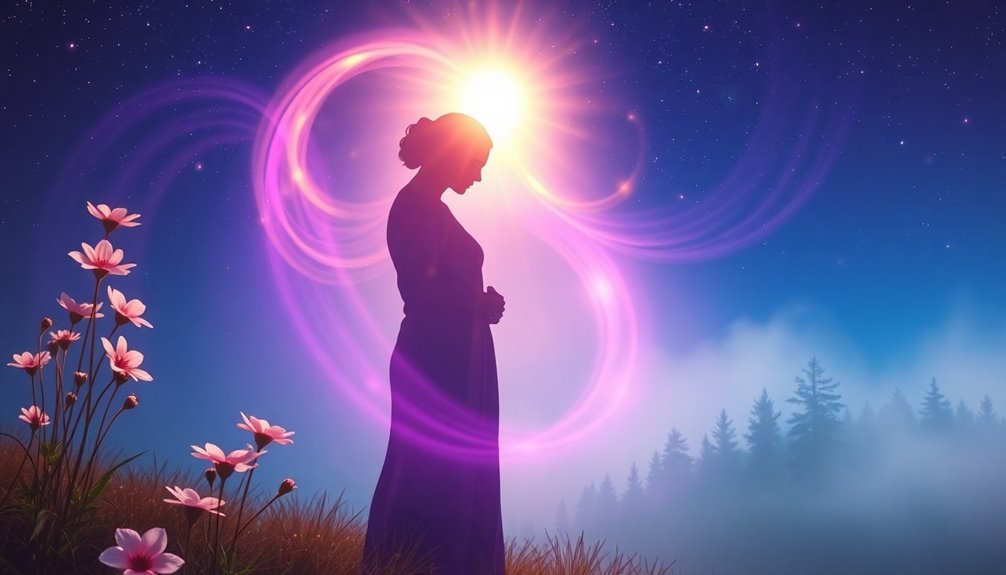Light blue stones and crystals, like Aquamarine and Celestite, help you cultivate serenity and peace in your life. These stones promote emotional healing by alleviating anxiety and enhancing clear communication. Aquamarine aids in challenging conversations, while Blue Lace Agate brings soothing energy to your day. You'll find that Celestite promotes restful sleep, and Angelite enhances feelings of compassion. Incorporating these beautiful crystals into your daily routine can transform your space into a serene sanctuary. As you explore their unique properties and uses, you'll discover even more ways these stones can bring calmness and clarity into your life.
Key Takeaways
- Light blue stones like Aquamarine and Blue Lace Agate promote emotional well-being and tranquility, aiding in stress relief and anxiety reduction.
- These crystals enhance communication, encouraging clear dialogue and emotional expression, particularly beneficial during challenging conversations.
- Incorporating light blue stones into daily life can create serene environments, fostering peace and clarity in personal spaces.
- Crystal grids utilizing light blue stones amplify calming energies, enhancing meditation practices and emotional balance through intentional layouts.
- Regular cleansing of light blue crystals ensures their vibrational energy remains potent, transforming spaces into sanctuaries of serenity and peace.
Overview of Light Blue Stones

Light blue stones, like Aquamarine and Blue Lace Agate, are more than just beautiful gems; they're powerful tools for emotional well-being. These stones possess calming properties that help you achieve emotional balance in your daily life.
Aquamarine, known for enhancing clear communication, is especially useful during challenging conversations, allowing you to express yourself without stress.
On the other hand, Blue Lace Agate offers soothing energy that alleviates anxiety and encourages relaxed self-expression. You might find it helpful when you're feeling overwhelmed or need to articulate your thoughts more clearly.
Additionally, Celestite, another light blue crystal, is celebrated for promoting restful sleep and emotional serenity, making it a great choice for nighttime routines.
Incorporating light blue stones into your meditation practices can deepen your connection to inner peace, fostering spiritual growth. Their serene vibrations create a tranquil atmosphere, helping you reduce stress and find clarity in your thoughts.
Whether you carry them with you or place them in your meditation space, these stones can enhance your overall emotional wellbeing and guide you toward a more balanced, serene life.
Benefits of Serenity and Peace

Serenity and peace play an essential role in maintaining your emotional and mental well-being. By incorporating light blue stones into your life, you can experience their calming energy, which promotes relaxation and reduces stress. These crystals, like Aquamarine and Blue Lace Agate, are linked to the Throat Chakra, enhancing communication and fostering emotional healing.
Here's a quick look at the benefits these stones offer:
| Benefit | Description | How to Use |
|---|---|---|
| Promote Relaxation | Light blue stones create a soothing environment. | Place them in your living space. |
| Emotional Healing | Helps process and release negative emotions. | Use during mindfulness practices. |
| Enhance Communication | Encourages clear and open dialogue. | Carry them while speaking. |
| Reduce Stress | Alleviates anxiety and fosters tranquility. | Meditate with them in hand. |
Embracing the serenity that light blue stones bring can greatly enhance your overall well-being. By making these crystals a part of your daily routine, you'll invite peace and clarity into your life, allowing for healthier relationships and a more balanced emotional state.
Notable Light Blue Crystals

When exploring notable light blue crystals, you'll discover a variety of stones, each with unique properties that can enhance your life.
Aquamarine, for example, radiates calming energy, perfect for reducing stress and anxiety while enhancing communication. This crystal not only promotes relaxation but also nurtures emotional balance, making it an excellent companion during challenging times.
Blue Lace Agate, with its delicate light blue hues and soothing properties, encourages confidence in self-expression and supports inner peace.
Similarly, Angelite fosters peace and compassion, facilitating spiritual growth and enhancing communication with higher dimensions.
Celestite, celebrated for its ethereal color, invites tranquility and enhances meditative experiences, making it a valuable tool for those seeking deeper connections with their inner selves.
Finally, Blue Calcite is known for its calming energy that aids in emotional release and aligns the throat and third-eye chakras, promoting serenity during grief.
Healing Properties of Blue Gemstones

When you explore the healing properties of blue gemstones, you'll find they offer significant emotional balance.
Stones like Aquamarine and Blue Lace Agate can help soothe your mind and foster clear communication, especially when addressing your throat chakra.
Emotional Balance Benefits
Light blue stones and crystals, such as Blue Lace Agate and Angelite, are celebrated for their emotional balance benefits. These soothing energies can greatly reduce anxiety and help you find inner peace. By incorporating light blue crystals into your life, you can enjoy the following benefits:
- Calming Properties: Crystals like Blue Calcite provide a sense of tranquility, alleviating emotional trauma and creating a peaceful atmosphere during stressful situations.
- Support Self-Expression: Aquamarine enhances clear communication, making it easier for you to articulate your feelings and overcome emotional turmoil.
- Emotional Healing: Sodalite fosters emotional balance by promoting rational thought, allowing you to navigate your emotions with clarity and confidence.
When you use these light blue crystals in meditation or daily routines, you'll experience a profound sense of emotional healing.
They encourage the release of negative emotions and cultivate a state of tranquility. Embrace the calming properties of light blue stones, and you'll not only reduce anxiety but also enhance your ability to express yourself and maintain emotional balance.
Throat Chakra Healing
Emotional balance is closely linked to effective communication, making light blue stones particularly powerful for Throat Chakra healing.
These stones, like Aquamarine and Blue Lace Agate, encourage clear communication and self-expression, promoting a sense of serenity. When you incorporate Sodalite or Angelite into your practice, you not only support your Throat Chakra but also foster honesty and authenticity in your conversations.
Using these blue gemstones during meditation can remarkably enhance your verbal articulation. As you meditate, focus on opening and aligning your Throat Chakra, allowing your inner voice to emerge freely. This practice can alleviate blockages, leading to improved confidence in expressing your thoughts and emotions.
Regular interaction with light blue stones helps maintain emotional balance, calming anxiety and empowering you to communicate your true feelings.
Whether you're seeking to enhance your speaking skills or simply want to express yourself more clearly, these stones are invaluable allies. By embracing the healing properties of light blue stones, you can create a harmonious flow of energy through your Throat Chakra, enriching both your personal and professional interactions.
Crystal Grids for Enhanced Energy

Crystal grids can really amplify the energies of light blue stones like Aquamarine and Blue Lace Agate, making them even more effective for emotional balance.
By arranging these crystals in specific layouts, you create a powerful flow of energy that enhances your meditation practices.
Let's explore how you can set up these grids to maximize their calming effects and support your self-expression.
Amplifying Gemstone Energies
When you arrange light blue stones like Aquamarine and Blue Lace Agate into a crystal grid, you create a powerful tool for amplifying their calming energies.
These arrangements not only enhance the inherent properties of the stones but also foster a serene environment that promotes emotional balance.
To maximize the benefits of your crystal grid, consider these key points:
- Use Specific Geometric Patterns: Arranging your light blue stones in specific patterns directs energy flow, making meditation and spiritual practices more effective.
- Incorporate Throat Chakra Crystals: Adding crystals like Blue Apatite or Lapis Lazuli can enhance communication and self-expression, fostering clarity of thought.
- Set Clear Intentions: Regularly revitalizing your grid and aligning it with your personal energy can markedly amplify the energetic properties, leading to desired outcomes.
Effective Grid Layouts
Harmony in energy flow is essential for creating effective crystal grids with light blue stones. To harness the calming properties of stones like Aquamarine and Blue Lace Agate, start by selecting a focal stone—preferably a larger piece of Aquamarine. Surround it with smaller light blue stones to establish a harmonious flow of energy. This arrangement enhances the tranquil vibrations, making it perfect for meditation spaces or bedrooms where you seek emotional balance.
Consider the geometry of your grid layout; using sacred shapes like the Flower of Life or a simple square can considerably influence energy flow. These configurations amplify the stones' abilities, promoting serenity and stress relief in your environment.
Don't forget the importance of cleansing your crystal grid regularly. Exposing your light blue stones to sunlight or moonlight helps maintain their high vibrational energy. By doing so, you guarantee that your grid remains effective in promoting tranquility and emotional balance.
As you create and maintain your crystal grids, you'll find that the gentle energies of light blue stones can transform your spaces into serene sanctuaries.
Enhancing Meditation Practices
To deepen your meditation experience, integrating crystal grids with light blue stones can greatly enhance your practice.
These grids, featuring stones like Aquamarine and Blue Lace Agate, amplify calming energy and foster a serene atmosphere that's perfect for meditation. By aligning with the Throat and Third Eye chakras, they facilitate a stronger spiritual connection and mental clarity.
Here are three ways to use crystal grids for enhanced meditation:
- Create Your Grid: Arrange light blue stones in a pattern that resonates with you. This intentional layout not only boosts the energy but also encourages emotional balance.
- Set Your Intention: Before meditating, focus on what you wish to achieve during your practice. Your crystal grid will help clear mental clutter and enhance your connection to your intentions.
- Place It Wisely: Keep your crystal grid in visible areas to serve as a reminder of serenity throughout the day. This constant presence makes it easier to enter a meditative state and maintain mindfulness.
Aesthetic Appeal of Light Blue Stones

Light blue stones, like Aquamarine and Blue Lace Agate, captivate with their soothing hues that evoke calmness and tranquility. Their aesthetic appeal lies in their glossy finish, which allows these crystals to sparkle and catch the eye. This shimmering quality increases their desirability as decorative pieces, whether in jewelry or home decor.
The unique patterns and variations found in light blue stones, particularly the delicate banding of Blue Lace Agate, add visual interest and character to each piece. These stones often blend seamlessly with other colors, making them popular choices for shiny bracelet sets that not only look stunning but also incorporate the healing properties of the stones.
When you incorporate light blue stones into your space, they can notably enhance the ambiance, promoting serenity and relaxation. Their calming visual presence makes them ideal for meditation areas or relaxation spaces, where you seek to cultivate serene energy.
Incorporating Blue Crystals in Daily Life

Incorporating blue crystals into your daily life can enhance not only your surroundings but also your well-being. These beautiful stones can help you achieve emotional balance and tranquility in various ways. Here are three effective methods to integrate them into your routine:
- Blue Lace Agate: Keep this crystal close during social interactions or presentations. It can improve your communication skills and alleviate anxiety, making it perfect for public speaking.
- Aquamarine: Use this calming stone during meditation. It promotes relaxation and clear communication, helping you connect deeply with your inner self.
- Blue Calcite: Wear Blue Calcite jewelry to enjoy its soothing energy throughout the day. It encourages emotional release and supports mental clarity, making it a great companion for stressful situations.
Additionally, place Celestite in your living space for a serene atmosphere, or carry Angelite in your pocket to maintain peace and compassion.
These crystals work together to reduce stress and promote a calming energy, making your day-to-day life more harmonious and fulfilling.
Choosing the Right Blue Gemstone

Choosing the right blue gemstone can greatly enhance your emotional and spiritual journey. Light blue gemstones, like Blue Lace Agate and Aquamarine, offer unique properties that can support your quest for serenity and emotional balance. When selecting a stone, trust your intuition—personal resonance matters.
Evaluate how each crystal connects to the throat chakra, as these stones promote clear communication and self-expression. Here's a quick reference table to help you decide which light blue gemstone aligns with your needs:
| Gemstone | Properties | Best For |
|---|---|---|
| Blue Lace Agate | Calming anxiety | Emotional balance |
| Aquamarine | Enhancing communication | Clear communication |
| Angelite | Spiritual connection | Intuition and peace |
| Blue Calcite | Emotional release | Stress relief |
| Larimar | Unique beauty | Collectors and aesthetic appeal |
Experiment with these options and see which resonates with you. Each stone carries a distinct energy that can enhance your spiritual connection while maneuvering through life's challenges. Embrace the journey of discovering your perfect light blue gemstone!
Frequently Asked Questions
What Is the Blue Stone for Inner Peace?
When you're seeking inner peace, consider blue stones like aquamarine or blue lace agate.
Aquamarine's calming energy helps you find tranquility and clear communication, while blue lace agate soothes anxiety and enhances self-expression.
You might also explore angelite, which encourages compassion and emotional serenity.
Celestite can promote restful sleep, and blue calcite aids in emotional release.
Each of these stones can support your journey towards a more peaceful state of mind.
What Gemstone Represents Serenity?
When you think about gemstones that represent serenity, you might consider aquamarine, blue lace agate, or celestite. Each one embodies calming energy, promotes emotional balance, and enhances restful sleep.
You'll find that angelite encourages peace and compassion, while blue calcite fosters clarity in communication.
What Do Blue Stones Mean Spiritually?
Blue stones hold significant spiritual meaning for you. They symbolize clear communication and emotional balance, helping you express yourself authentically.
These stones promote tranquility, allowing you to relieve stress and calm your mind. When you connect with blue gemstones, like Aquamarine or Blue Lace Agate, you encourage a deeper spiritual awakening and intuitive understanding.
They also serve as protective talismans, transforming negative energy into positive vibrations and supporting your personal growth journey.
What Are Light Blue Crystals Called?
Light blue crystals are often referred to as "sky blue" or "aqua" stones.
You'll find popular varieties like Aquamarine, Blue Lace Agate, and Celestite among these beautiful gems.
Each one boasts unique properties, such as promoting tranquility or enhancing communication.
When you explore these crystals, you'll discover their calming energies and how they can support emotional balance and clarity.
Conclusion
Incorporating light blue stones into your life can truly help you find your inner calm. These gems aren't just pretty to look at; they bring a sense of peace that can help you navigate life's ups and downs. By choosing the right blue crystal, you're not just picking a decoration; you're inviting serenity into your space. So, take the plunge and let these soothing stones guide you toward a tranquil and balanced existence.









